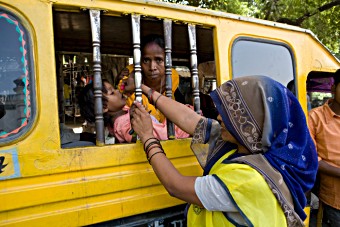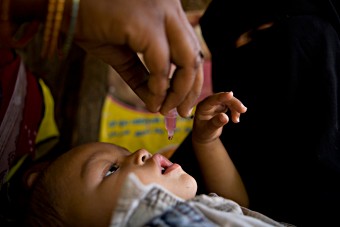World Polio Day: Reflecting on a 2003 experience of polio in India

Raj Kumar
GAVI senior program manager
2011

A volunteer checks the little finger of a child to see whether it has been immunised against polio, and administers a drop of oral polio vaccine while the child is still sitting in the traffic during an April 2008 immunization effort in India. Source: Rotary International/2008.
When the news came through in Andhra Pradesh that we had our first polio case for seven years, I was advising the state government on introducing hepatitis B and Japanese encephalitis vaccines.
Mainly affecting children under five, polio can lead to irreversible paralysis for about one in 200 infections. It can also lead to death if the paralysis interrupts the breathing.
Those who have lived and worked in less-developed countries are all too familiar with the terrible disability and deformation that polio leaves in its wake.
But, as with smallpox, polio is one of a handful of diseases that cannot survive for long outside the human body. And eradication is a real possibility.
When we have such effective vaccines, the single biggest obstacle to polio eradication is the strength of our immunisation systems. If the routine immunisation system is working, polio will not spread.
So while the child’s parents were willing him to survive and adjusting to the likelihood that survival would also mean permanent disability, I was fretting about our system. The next 30 cases highlighted weaknesses, but a well-aimed immunisation campaign finished off the outbreak.

A social health activist administers drops of the oral polio vaccine to a child in April 2008 during a door-to-door immunisation effort in India. Source: Rotary International/2008.
Around the world, high immunisation coverage with four doses of oral poliovirus (OPV) vaccine for infants has been key to polio eradication efforts. Indeed, enormous synergies exist between polio eradication and routine immunisation, because routine immunisation systems are still the most efficient and effective way of getting polio vaccination to where it’s needed most.
Persistent transmission in Pakistan and major outbreaks in Chad and the Democratic Republic of Congo reflect ongoing weaknesses in immunisation systems.
My country, India, is one of four countries in the world where polio is endemic, but since January 2011, it has not seen a single case of polio. This shows that eradication is possible.
Eradicating polio will be a tremendous demonstration of immunisation’s power, allowing countries like my own to focus on other life-saving vaccines.
Victory against polio will be triumph for us all.
Dr Raj Kumar is an Indian national. Between 2002 and 2006, he advised the state of Andhra Pradesh, population 75 million, on immunisation. Now as a Senior Programme Manager for GAVI, he manages GAVI’s portfolio in 13 countries across the Middle East and East Asia.
